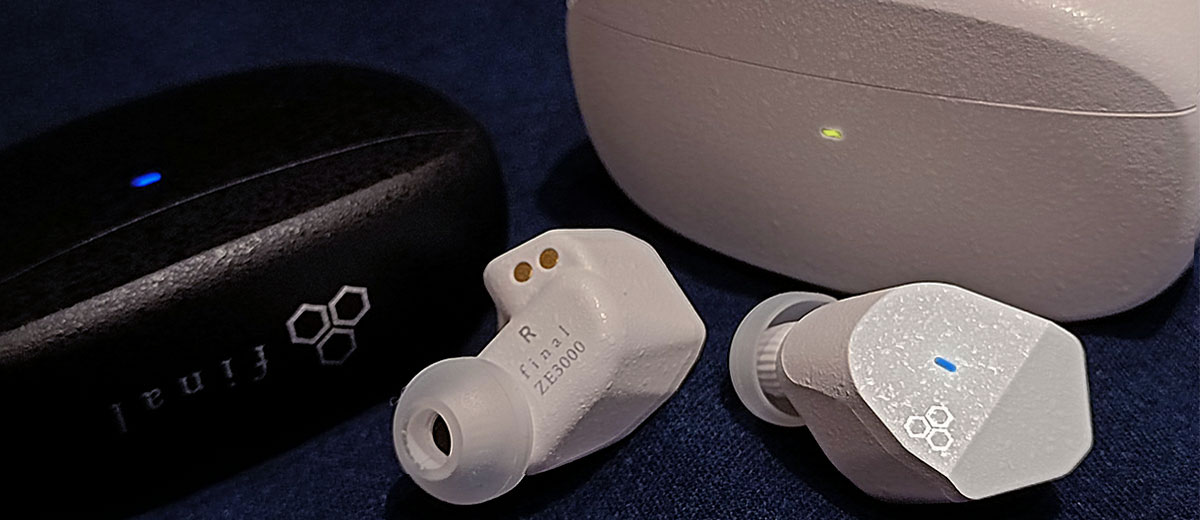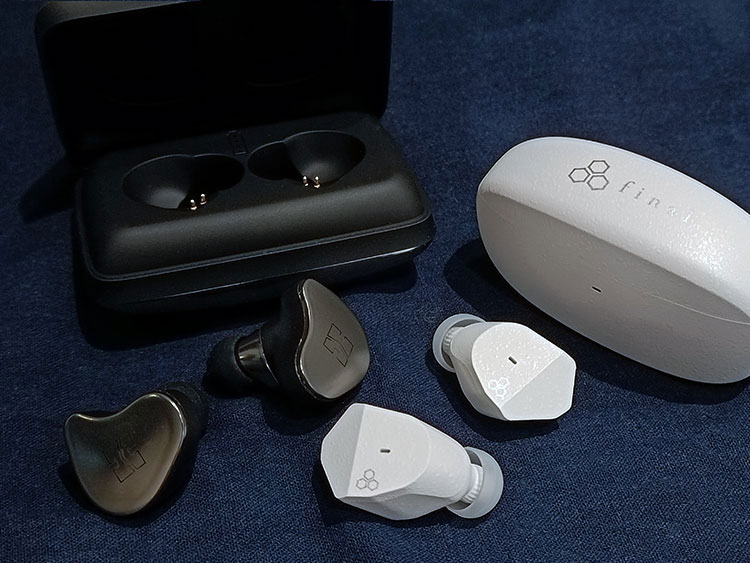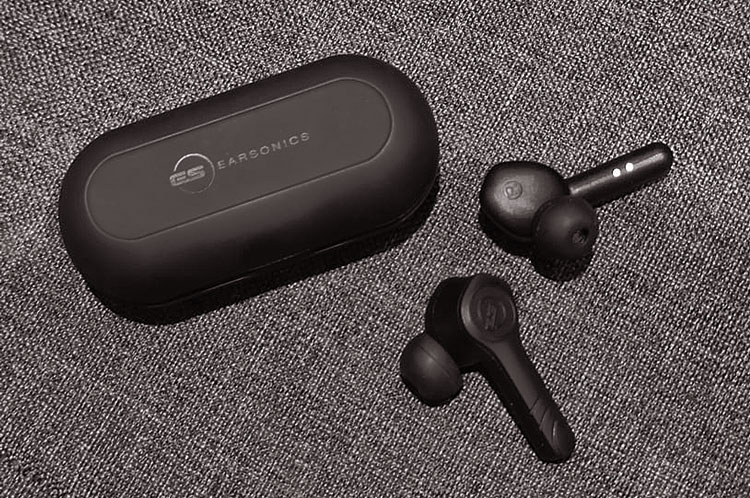Wireless Performance
Range & Stability
Like how I usually test my TWS earphones I stream on my smartphone with Spotify and Tidal, as well as using local Redbook WAV files from the local storage.
Whilst testing on the train the connection is very stable without any interference. When testing indoors by putting apart the source 10 feet from myself and turning around, the signal is still strong without any disconnection issue/stuttering even with an aptX connection.
Latency
The ZE3000 supports aptX Low Latency and aptX adaptive which makes it a more suitable candidate for gaming or video editing.
More phones are getting aptX adaptive support and you can manually select the Codec in the Bluetooth settings. This will make an audible difference in response time compared to the very small delay detectable when playing music games with other Codecs.
Select Comparisons
final EVA2020
$259
Technical
Looking closely at the designs you will notice a handful of differences between the EVA2020 and the ZE3000. The new design updates the Bluetooth chipsets to QCC3040 from QCC3020 to support the higher Bluetooth 5.2 standard and aptX LL/adaptive.
It also revamps the chamber design and the driver placement, with an additional vent near the front side of the driver that links to a secondary sound chamber for air pressure control. This is unleashing a new level of performance.
In addition, the ZE3000 is embedded with the newly designed driver “f-Core for Wireless” which enhances distortion control by reducing the weight of the membrane parts as well as production accuracy.
In comparison, the EVA2020 is using an older solution that is not optimized for wireless implementations. Looking closely at the internals from the picture on page 1, the driver is tilted at an angle in the ZE3000’s design.
Design
The final EVA2020 has been one of the coolest choices for TWS earphones with sharp colors from the Neon Genesis Evangelion theme. You may have also noticed its big charging cradle which holds 3x the capacity of the ZE3000’s cradle.
Practically the max playback time for one single charge to the cradle with the EVA2020 is double that of the ZE3000, though the size of the cradle is also doubled and is not as portable.
While the EVA2020 has some unique selling points and design themes, the ZE3000 looks more mature in design and perhaps even more futuristic looking with sharper edges and stronger contours, also a clean palette from tip to the body. The frosty faceplate is also more textured to the touch and feels a tad bit classier.
Performance
The EVA2020 didn’t capture market attention just by its aesthetics. It is very engagingly tuned with a good tonal balance plus clarity in mind. The midrange frequencies on EVA2020 are very smooth with the vocal sweetened by a gentle roll-off in the treble.
Compared to the ZE3000 its vocal colorings are stronger and sweeter though not as clearly outlined and naturally rendered as the ZE3000.
Regardless of the lower price, the performance on the ZE3000 in staging, imaging precision, resolution, and bass layering all seems to be enhanced. At first glance, it may seem that the vocal is not as polished on the ZE3000 compared to the EVA2020. However, when you pump up the volume you will realize the ZE3000 preserves more details without making the vocal sound harsh.
It also helps to keep more air in the mix and at the same time doing a good job to hold the image tight from loosening and distorting.
HIFIMAN TWS800
$299
Technical
The HIFIMAN TWS800 uses the company’s special topology diaphragm on its single dynamic driver TWS. Similar to the ZE3000, it is also IPX4 certificated and can replay music for up to 35 hours total.
What makes it very different is the 150Ω rated driver with super sensitive rare earth magnets, also high-strength nano-particle coating plated on top that aims it bringing down distortion through reinforcing the membrane.
ZE3000 takes a very different approach to material design and increases the sensitivity by lowering the weight and maximizing the area of the membrane. It also uses a secondary sound chamber for pressure regulation compared to the TWS800’s huge housing.
The TWS800 also uses a discrete power supply for the amping circuitry and bigger caps to handle fast power draw when the bass kicks deep. While it also runs on Bluetooth 5.0 there is no aptX support and it connects with AAC and SBC codecs only, inevitably giving it harder times against new competition in terms of specifications.
Design
Both TWS are similar in terms of protruding design, though the TWS800 obviously catches up with more noise from the surrounding especially when it gets windy. ZE3000 is lighter and sits more securely in the ear, also providing better isolation and instant fit thanks to final’s tips that offer a better seal and adhesion to the ears.
The control function goes head-to-head on the two TWS items and I find the ZE3000 slightly more sensitive on the touch panel. You may have noticed that the TWS800 does not have a mic onboard, so you will have to talk on your phone when doing a video call.
Performance
The TWS800 has a unique product proposition, and it is proven to sound engaging and very opened up without using the more advanced codecs.
Compared to the ZE3000 it put more emphasis on the lows and its mids are colored fuller, yet the detail retrieval power, especially with acoustic instruments, falls short especially at higher sound intensity.
The colorings in the upper mids of the TWS800 also make it sound more soothing with pop songs though it doesn’t feel as dense and resolving in the mids as the ZE3000.
The TWS800 has a more W-shaped tuning and impactful bass that gives a more dynamic presentation with a bolder vocal image. The ZE3000 is much less colored and is more polite in the lower register comparatively, tuned towards being more responsive to subtle details and loyal in the vocal department.
Both systems have an expansive stage but the TWS800 is the more cozy and warm sounding one that works well for relaxing jazzes and R&B. For those who seek details and accuracy in tonality, the ZE3000 is clearly the one I would pick. You will be wowed that a TWS can come close, if not better than wired IEMs in terms of transients and distortion control.
Earsonics AERO
$199
Technical
This very compact AERO TWS from Earsonics is equipped with an IPX4 waterproof design, Bluetooth 5.0, and Qualcomm aptX technology. The AERO houses a 6mm graphene dynamic driver and is equipped with a digital processor incorporating AEQ (Active Audio Processing) algorithms.
Another practical feature is the fast-changing technology that allows a 15 mins charge to deliver up to 2 hours of listening. The weight, battery size, and membrane diameter are similar for the two TWS that is why I am putting these two items head-to-head to see which one performs better.
Design
One very practical feature of the AERO is that it supports fast charge, so you will get 2 hours of listening with just 15 minutes on the charger, perfect for those who are forgetful with charging their cradles. The extended mic design also allows the AERO to pick up clearer voices during a call.
In terms of build quality final is doing a fantastic job, and it feels much more textured and solid in assembly as well as hiding all the molding marks nicely. The AERO has a more common design similar to EarPods and you can see the injection molding marks, yet the dark theme keeps it subtle.
Performance
The AERO has a rather neutral tuning and attempts to achieve an expanded stage while keeping the edges of the vocal much like ZE3000 does to sound unaltered in the midrange.
The response speed in ZE3000 is ahead thus it sounds clearer and more resolving, also densely impacting in the mid-lows. While both items are not pronounced in the mids the ZE3000 is richer in details and remarkably smoother in articulation.
Treble on the AERO is more attenuated than the ZE3000 so it sounds darker comparatively. That works with music that is overly hot, and would shift your focus to string instruments and the bass, yet that will compromise some air as well as the openness that comes along.
In short, the ZE3000 sounds more natural and realistic without leaning towards either end of the frequency spectrum and is able to deliver finer details, especially in the mids.
Our Verdict
final has done a great job putting together this subtly beautiful Japanese design and possibly the most unaltered sound I have experienced on a TWS so far.
You can experience the effort that goes into bringing forward higher fidelity and musicality through acoustic designs, instead of boosting the dynamics to hide flaws due to portable power constraints.
The ZE3000 replays any music truthfully and in an immersive way. The tranquil mood brought by the very balanced and effortlessly extended tuning, also the clear positionings of instruments even at high volume, may confuse you as if this is not a wireless item.
Overall, the almost feather-light housing, non-intrusive tuning approach, agile response with plenty of air, and excellent distortion control on the final ZE3000 brought by newer driver technologies add up to a perfect companion for long listens without any fatigue.
Final ZE3000 Specifications
- Bluetooth version: 5.2
- Supported codecs SBC, AAC, Qualcomm® aptX ™, aptX ™ Adaptive
- Continuous music playback time Up to 7 hours / Case included: Up to 35 hours
- Charging time: Earphone body: Approximately 1.5 hours / Charging case:
- Approximately 2 hours
- Battery capacity: Earphone body: 35mAh / Charging case: 300mAh
- Waterproof performance: IPX4





